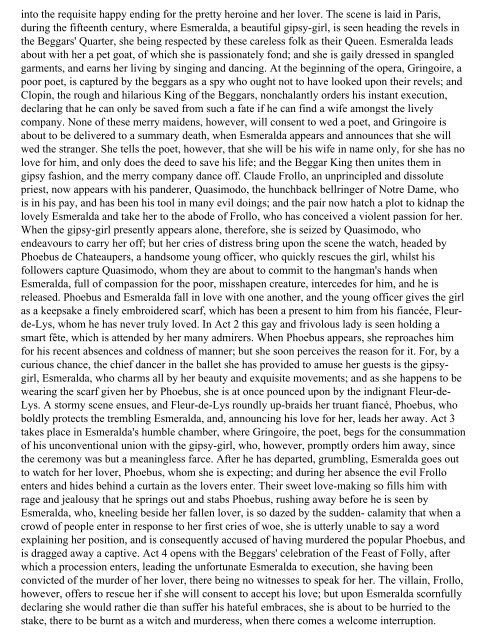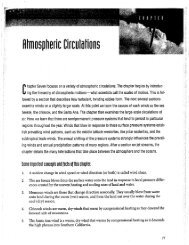Opera Plots I - MDC Faculty Home Pages
Opera Plots I - MDC Faculty Home Pages
Opera Plots I - MDC Faculty Home Pages
Create successful ePaper yourself
Turn your PDF publications into a flip-book with our unique Google optimized e-Paper software.
into the requisite happy ending for the pretty heroine and her lover. The scene is laid in Paris,<br />
during the fifteenth century, where Esmeralda, a beautiful gipsy-girl, is seen heading the revels in<br />
the Beggars' Quarter, she being respected by these careless folk as their Queen. Esmeralda leads<br />
about with her a pet goat, of which she is passionately fond; and she is gaily dressed in spangled<br />
garments, and earns her living by singing and dancing. At the beginning of the opera, Gringoire, a<br />
poor poet, is captured by the beggars as a spy who ought not to have looked upon their revels; and<br />
Clopin, the rough and hilarious King of the Beggars, nonchalantly orders his instant execution,<br />
declaring that he can only be saved from such a fate if he can find a wife amongst the lively<br />
company. None of these merry maidens, however, will consent to wed a poet, and Gringoire is<br />
about to be delivered to a summary death, when Esmeralda appears and announces that she will<br />
wed the stranger. She tells the poet, however, that she will be his wife in name only, for she has no<br />
love for him, and only does the deed to save his life; and the Beggar King then unites them in<br />
gipsy fashion, and the merry company dance off. Claude Frollo, an unprincipled and dissolute<br />
priest, now appears with his panderer, Quasimodo, the hunchback bellringer of Notre Dame, who<br />
is in his pay, and has been his tool in many evil doings; and the pair now hatch a plot to kidnap the<br />
lovely Esmeralda and take her to the abode of Frollo, who has conceived a violent passion for her.<br />
When the gipsy-girl presently appears alone, therefore, she is seized by Quasimodo, who<br />
endeavours to carry her off; but her cries of distress bring upon the scene the watch, headed by<br />
Phoebus de Chateaupers, a handsome young officer, who quickly rescues the girl, whilst his<br />
followers capture Quasimodo, whom they are about to commit to the hangman's hands when<br />
Esmeralda, full of compassion for the poor, misshapen creature, intercedes for him, and he is<br />
released. Phoebus and Esmeralda fall in love with one another, and the young officer gives the girl<br />
as a keepsake a finely embroidered scarf, which has been a present to him from his fiancée, Fleurde-Lys,<br />
whom he has never truly loved. In Act 2 this gay and frivolous lady is seen holding a<br />
smart fête, which is attended by her many admirers. When Phoebus appears, she reproaches him<br />
for his recent absences and coldness of manner; but she soon perceives the reason for it. For, by a<br />
curious chance, the chief dancer in the ballet she has provided to amuse her guests is the gipsygirl,<br />
Esmeralda, who charms all by her beauty and exquisite movements; and as she happens to be<br />
wearing the scarf given her by Phoebus, she is at once pounced upon by the indignant Fleur-de-<br />
Lys. A stormy scene ensues, and Fleur-de-Lys roundly up-braids her truant fiancé, Phoebus, who<br />
boldly protects the trembling Esmeralda, and, announcing his love for her, leads her away. Act 3<br />
takes place in Esmeralda's humble chamber, where Gringoire, the poet, begs for the consummation<br />
of his unconventional union with the gipsy-girl, who, however, promptly orders him away, since<br />
the ceremony was but a meaningless farce. After he has departed, grumbling, Esmeralda goes out<br />
to watch for her lover, Phoebus, whom she is expecting; and during her absence the evil Frollo<br />
enters and hides behind a curtain as the lovers enter. Their sweet love-making so fills him with<br />
rage and jealousy that he springs out and stabs Phoebus, rushing away before he is seen by<br />
Esmeralda, who, kneeling beside her fallen lover, is so dazed by the sudden- calamity that when a<br />
crowd of people enter in response to her first cries of woe, she is utterly unable to say a word<br />
explaining her position, and is consequently accused of having murdered the popular Phoebus, and<br />
is dragged away a captive. Act 4 opens with the Beggars' celebration of the Feast of Folly, after<br />
which a procession enters, leading the unfortunate Esmeralda to execution, she having been<br />
convicted of the murder of her lover, there being no witnesses to speak for her. The villain, Frollo,<br />
however, offers to rescue her if she will consent to accept his love; but upon Esmeralda scornfully<br />
declaring she would rather die than suffer his hateful embraces, she is about to be hurried to the<br />
stake, there to be burnt as a witch and murderess, when there comes a welcome interruption.













